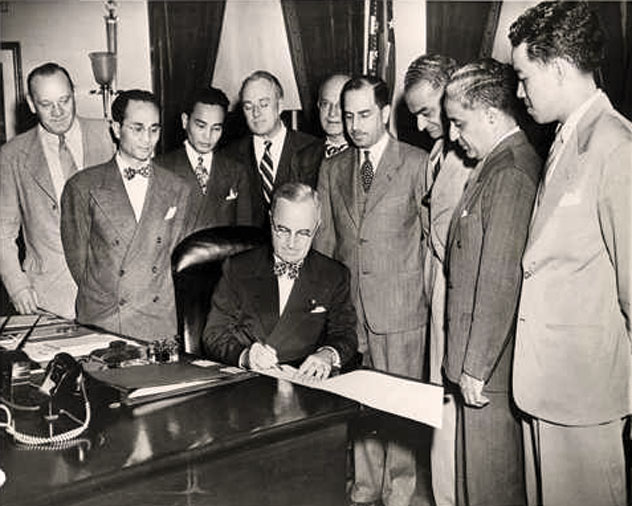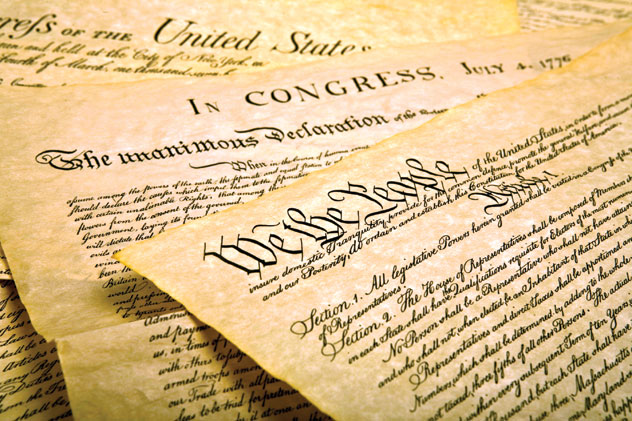OPINION:
The 'Real' Independence Day: An Indian American Perspective
The Fourth of July is American Independence Day. It commemorates the adoption of the Declaration of Independence on July 4, 1776, declaring independence from Great Britain. It has been a federal holiday since 1941. Independence Day is celebrated with festivities ranging from patriotic displays, fireworks, parades, concerts, political speeches and ceremonies, in addition to casual family gatherings and barbecues. But, in essence, the ‘real’ Independence Day for Indian Americans was the day when the Immigration Act of 1946 was passed, opines Inder Singh.

(Above): In 1946, President Truman took special interest in the passage of the Luce-Cellar Bill, which was subsequently passed by the U.S. Congress. President Truman signed the bill on July 2, 1946. On July 2, Luce-Cellar Bill became law as the Immigration Act of 1946, conferring rights of citizenship on the natives of India. [PHOTO: Harry Truman Presidential Library]
Indians started coming to the United States in the beginning of the twentieth century. They soon found out that the phrase “All men are created equal” in the Declaration of Independence, applied only to white people and “Life, Liberty and the pursuit of Happiness” in the Declaration, was also not meant for Indian nationals. They, in fact, faced prejudice, hostility and blatant discrimination from the American people.
The majority of the arrivals from India were Sikhs who preserved their religious beliefs and practices by keeping a beard, long hair on their head and wearing a turban. They were easily distinguishable from the rest of the immigrants. But, unfortunately, they were called “Rag heads,” a derogatory term used for the Indians at that time. Also, all Indians were commonly called “Hindoos” (“Hindus”) irrespective of their faith. The very presence of Hindus in America provoked hostility from the Asiatic Exclusion League which carried propaganda against the “Hindu invasion of America” and persuaded the media to write against “The Tide of Turbans.”
The employers preferred the Indians to the whites but the unions despised them. As the number of Indian workers increased within a span of few years, they started encountering rampant prejudice and widespread hostility. In 1907, Indians became the victims of racial riots in Bellingham, a milling town in the state of Washington. The chief objective of the attack was to “scare them so badly that they will not crowd white labor out of the mills.” The nightmarish incident forced about 300 Indians, employed in various mills, to leave the town in fear.
The Asiatic Exclusion League and other similar groups became emboldened and wanted to prevent further immigration from India and force those already in the country to go back. Anti-Indian immigration groups also succeeded in getting the Alien Land Law passed in 1913, a new law that prevented “aliens ineligible for citizenship” to own property in California.
The U.S. citizenship conferred many rights and privileges but only white immigrants were eligible to apply. Indian nationals without citizenship, continued to suffer humiliation and hardships.

The U.S. Congress could pass a law to grant U.S. citizenship to 2,000 or possibly 2,500 Indians in America. But majority of the Indians were very skeptical if Congress would pass such a law. “It was not that they did not want citizenship rights, but they had suffered so many hardships and been knocked about so much that it was very difficult for them to believe that there was a chance of their winning.” (Saund: Congressman from India)
J.J. Singh of India League of America, Mubarak Ali Khan of the Indian Welfare League, Anup Singh, Haridas Muzumdar, Taraknath Das, and from California, Dalip Singh Saund of the India Association of America, led the lobbying effort for citizenship rights. They were able to successfully convince Connecticut Republican Congresswoman Clare Booth Luce, and New York Democrat Congressman Emanuel Cellar, chair of the House Judiciary Committee, to jointly introduce a bill in Congress for the grant of U.S. citizenship to Indian immigrants.
However, selling this concept to the majority of the members in the U.S. Congress was an uphill task at that time, more so as the passage of the bill could open the door for other Asians who were similarly deprived of citizenship rights. For four years, the bill languished in the Congressional Committees and Indians continued running into obstacles in finding a powerful ally to push it through Congress. Although, President Roosevelt wrote letters to Congressmen and Senators but some diehard members of Congress and the American Federation of Labor would not relent in their opposition.
Fortunately, in 1946, President Truman took special interest in the passage of the Luce-Cellar Bill, which was subsequently passed by the U.S. Congress. President Truman signed the bill on July 2, 1946, in the presence of several people including Sardar J.J. Singh of New York, president of the India League and Dr. Anoop Singh of Washington DC. On July 2, Luce-Cellar Bill became law as the Immigration Act of 1946, conferring rights of citizenship on the natives of India. This day, in essence, should be considered as the Independence Day for Indian Americans.
The U.S. proclaims “liberty and justice for all.” For the first time, Indians felt that this phrase applied to them as well. Indian Americans should celebrate America’s independence enthusiastically on July 4. At the same time, Indian civic organizations should organize annual celebration of July 2 as the day when Indians achieved parity, equality and dignity in America.
The grant of citizenship rights opened new opportunities for Indian nationals. They could lease or own land, which previously they could not under the Asiatic Exclusionary laws, or take part in an election, or even run for a public office. They could now also go back for a visit to India or bring their spouse and minor children to the U.S. There was no longer a bar on love relationship; an Indian could marry an American citizen.
|